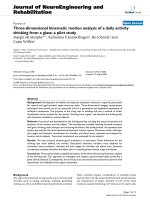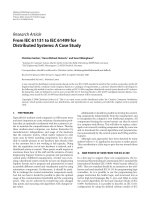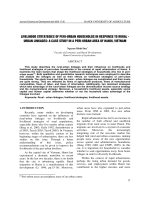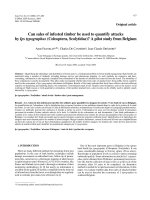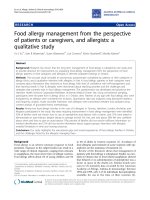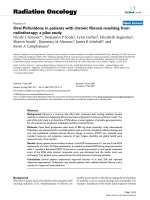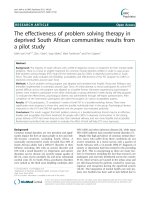Treating wastewater from households along mae kha canal using hedychium coronarium – a pilot study in thailand
Bạn đang xem bản rút gọn của tài liệu. Xem và tải ngay bản đầy đủ của tài liệu tại đây (1.31 MB, 57 trang )
THAI NGUYEN UNIVERSITY
UNIVERSITY OF AGRICULTURAL AND FORESTRY
NGUYEN MINH CHAU
TOPIC TITLE: TREATING WASTEWATER FROM HOUSEHOLDS
ALONG MAE KHA CANAL USING HEDYCHIUM CORONARIUM
A PILOT STUDY IN THAILAND
BACHELOR THESIS
Study mode
: Full-time
Major
: Environmental Science and Management
Faculty
: International Program Office
Batch
: 2014-2018
Thai Nguyen, 21/10/2018
i
DOCUMENTATION PAGE WITH ABSTRACT
Thai Nguyen University of Agriculture and Forestry
Degree Program
Bachelor of Environmental Science and Management
Student name
Nguyen Minh Chau
Student ID
DTN1454290003
Thesis title
Treating wastewater from households along Mae Kha
canal using Hedychium coronarium – a pilot study in
Thailand
Associate. Prof. Dr.Arunothai Jampeetong
Department of Biology, Faculty of Science, Chiang Mai
University
Supervisors
PhD. Hoang Hai Thanh
Advanced Education Program Office, Thai Nguyen
University of Agriculture and Forestry
Supervisor’s signature
Abstract:
Chiang Mai, Thailand is one of the most famous destinations for tourists
worldwide. Unfortunately, the water pollution is a problem that has been interfering
residents’ life and economic development due to rapid urbanization. One of the most
serious cases is Mae Kha canal which is an important feature in Chiang Mai's water
system. This research, therefore, aims to help local resident building cost-effective
wastewater treatment models called Constructed Wetlands (CWs) in order to filter
sewage at household level before it was release into the environment. The experiment
consisted of four tanks covered with Hedychium coronarium and four control tanks, all
set up at Department of Biology, Faculty of Science - Chiang Mai University. The
water sample was collected from municipal sewer then separated by two different
buckets in which it was treated with and without oxygen addition throughout six
weeks. In this study, Hedychium coronarium – a non-common wetland plant, was
selected as it is recorded able to lessen mosquito appearance which certainly is one of
the drawbacks of CWs. The experiments goals were to estimate the average percentage
of parameters removed by Hedychium coronarium in terms of COD, TSS, PO4-P,
NH4-N, NO3-N. The percentage removal in COD, TSS, PO4-P, NH4-N, NO3-N were
ii
83%, 82.6%, 93%, 89%, 84.7% respectively. It initially proved that the removal
efficiency of Hedychium coronarium is as high as others wetland plants and expected
to inspire future researchers in continuing to apply new plants to lessen CWs’
perennial problems and optimize its benefits in wastewater treatment.
Keywords:
Constructed wetlands (CWs), water quality, Hedychium
coronarium, percentage removal.
Number of pages
48 pages
Date of submission
21/10/2018
iii
ACKNOWLEDGEMENT
First and foremost, I would like to thank my supervisor Assoc. Prof. Dr.
Arunothai Jampeetong for being supportive during my difficult time. She had set an
example of excellence as a researcher, mentor, instructor, who always prioritize her
students and science.
I would like to thank my instructor, Tararag Pincam for always being so
patient with me even though I misunderstood and made troubles many times. She
always supported me with my works as well as treated me as a sister and gave me
various valuable advices in life.
I would like to thank my supervisor Dr. Hoang Hai Thanh from Vietnam for
her constant support.
I would like to say thank to all members in Biology laboratory of Faculty of
Science, Chiang Mai University, they were always kind to me and never hesitated to
give me a hand.
Finally, I would like take this opportunity to extend my sense of gratitude to my
family and friends who always believe in me and backing me unceasingly.
NGUYEN MINH CHAU
iv
TABLE OF CONTENTS
LIST OF FIGURES .....................................................................................................vii
LIST OF TABLES ..................................................................................................... viii
LIST OF ABBREVIATION ........................................................................................ ix
PART I. INTRODUCTION .......................................................................................... 1
1.1.Background and rationale .......................................................................................... 1
1.2.Objectives .................................................................................................................. 2
1.3. Research questions and hypotheses .......................................................................... 3
1.3.1. Research questions..........................................................................................3
1.3.2. Research hypotheses .......................................................................................3
PART II. LITERATURE REVIEW ............................................................................ 4
2.1. Water pollution in Mae Kha canal............................................................................ 4
2.2. How about solutions? ............................................................................................... 7
2.2.1. Previous solutions ...........................................................................................7
2.2.2. Constructed Wetland ......................................................................................8
2.3. Hedychium coronarium (White Ginger) ................................................................ 12
PART III. MATERIALS AND METHODS ............................................................. 15
3.1. Surveying ................................................................................................................ 15
3.2. Domestic wastewater treatment using CW models with Hedychium coronarium. 16
3.2.1. Materials .......................................................................................................16
3.2.2. Experimental set up .....................................................................................17
3.2.3. Water Sampling and analysis........................................................................19
3.2.4. Statistical analysis .........................................................................................20
PART IV. RESULTS AND DISCUSSION ............................................................... 21
4.1. Surveying results: ................................................................................................... 21
v
4.1.1. General background of the communities ......................................................21
4.1.2. Household’s wastewater management ..........................................................21
4.1.3. How can water pollution in Mae Kha canal affect resident’ lives? ..............22
4.1.4. How resident think about Constructed wetlands? ........................................23
4.2. Domestic wastewater treatment using CW models with Hedychium coronarium. 24
4.2.1. Removal of COD ..........................................................................................24
4.2.2. Removal of TSS ............................................................................................ 26
4.2.3. Removal of PO4-P.........................................................................................28
4.2.4. Removal of NH4-N and NO3-N: ...................................................................30
PART V. CONCLUSION ........................................................................................... 35
REFERENCES ............................................................................................................ 36
APPENDIX................................................................................................................... 43
Appendix 1 .................................................................................................................... 44
Appendix 2 .................................................................................................................... 48
vi
LIST OF FIGURES
Figure 1.1: Mae Kha canal in city moat .......................................................................... 2
Figure 2.1: Wastewater sources to Mae Kha canal ......................................................... 6
Figure 2.2: Hedychium coronarium .............................................................................. 13
Figure 3.1: Study sites ................................................................................................... 16
Figure 3.2: Designed constructed wetland models. ....................................................... 17
Figure 4.1: Domestic wastewater effluents in resident’ view ....................................... 22
Figure 4.2: Main sources of wastewater before drained out ......................................... 23
Figure 4.3: Resident’ preference towards two constructed wetland size ...................... 24
Figure 4.4: Percentage removal in COD by mass ......................................................... 26
Figure 4.5: Percentage removal in TSS by mass ........................................................... 27
Figure 4.6: Percentage removal in PO₄-P by mass ....................................................... 29
Figure 4.7: Nitrogen transformation in nature ............................................................... 31
Figure 4.8: Percentage removal in NH₄-N by mass ...................................................... 32
Figure 4.9: Percentage removal in NO₃-N by mass ...................................................... 33
Figure A1: Residents worried when talking about Mae Kha canal ............................... 48
vii
LIST OF TABLES
Table 3.1: The difference between before and after domestic wastewater was added
oxygen………………………………………………………………………………...18
Table 3.2: Water analysis using standard methods …………………………………..19
Table 4.1: COD removal mass in percentage after each week …………………….....26
Table 4.2: TSS removal mass in percentage after each week………………………...28
Table 4.3: PO₄-P removal mass in percentage after each week ……………………...29
Table 4.4: NH₄-N removal mass in percentage after each week……………………...32
Table 4.5: NO₃-N removal mass in percentage after each week……………………...33
viii
LIST OF ABBREVIATION
CWs
Constructed wetlands
FWS
Free water surface
HSF
Horizontal subsurface flow
SSF
Subsurface flow
VF
Vertical flow
ix
PART I. INTRODUCTION
1.1.
Background and rationale
In this era, human being is facing water crisis and water pollution due to rapid
economic growth since the First Economic Revolution in 18 century. Water pollution
is not an unfamiliar topic nowadays, especially in the case of developing countries,
where economic development is still depending significantly on natural resources.
Moreover, the anthropogenic pollutants from industrial, domestic and agricultural
waste are ultimately absorbed by aquatic plants and animals. Thailand, one of
Southeast Asia’s tiger economies is facing the same environmental problem. Water
quality in Thailand has declined, alarming health risks if water is not purified before
consumption. According to Brianna in 2017 there are approximately 43 million Thai
people drinking contaminated water, allowing diseases like diarrhea, typhoid and
dysentery to enter their system; this water is contaminated primarily by pollutants
disposed into rivers and streams. Water quality in Thailand varies throughout the
country. In Chiang Mai city, which located in northern Thailand, a city famous for its
rich culture heritage but water degradation here has been a serious concern for both
resident and local authority in many years, one of the prominent polluted water bodies
is Mae Kha canal. Many projects and researches had been carried out to solve that
problem, but until now, resident live along the water source still find Mae Kha canal is
in poor conditions and gradually turn their back on the canal (Sunantana , 2016). The
current situation is shown in Figure 1.1 below. People have complained that the
wastewater from local houses especially slums was the main cause of pollution,
besides, resident littering also add to the problem (Sunantana, 2016; Harmony, 2006;
Unchulee, 2014). This is worsened by environmental policies, which are concerned
1
with city aesthetics rather than environmental rehabilitation or protection (Ribeiro &
Srisuwan, 2005).
Figure 1.1: Mae Kha canal in city moat
Among all of current methods, there is a method which can both achieve high
pollutant removal rate and aesthetic appearance that is Constructed wetlands (CWs).
Conventional wastewater treatment plants involve large capital investments and
operating costs not mention to a large area to build the whole systems. In contrast,
Constructed wetlands offer low cost operation and maintenance since no mechanical
components or external energy is required (Sohair, 2013). Therefore, in this study, four
small duplicates of Constructed wetland planted with Hedychium coronarium were
created in greenhouse conditions of Department of Biology, Faculty of Science,
Chiang Mai University and treated by domestic wastewater collected from municipal
pipe systems along the canal.
1.2.
Objectives
This study has two objectives, they are:
1.
To introduce CWs to resident who live along Mae Kha canal bank.
2
2.
To evaluate the percentage removal of pollutant factors in domestic
wastewater after treated by CW models using Hedychium coronarium.
1.3.
Research questions and hypotheses
1.3.1. Research questions
❖
Question 1: How well local resident accepted the idea of building CWs
in their community to treat domestic wastewater?
❖
Question 2: Would the Constructed wetland models used Hedychium
coronarium achieve good percentage removal like other wetland plants?
1.3.2. Research hypotheses
In this study, question 1 was expected to receive various responses whereas
question 2 was expected to test two hypotheses below.
Question 2: Would the Constructed wetland models used Hedychium
coronarium achieve good percentage removal like other wetland plants?
- Null hypothesis (Ho): There is no significant between Hedychium coronarium
percentage removal and that in other wetland plants.
- Alternative hypothesis (Ha): There is a significant between Hedychium
coronarium percentage removal and that in other wetland plants.
3
PART II. LITERATURE REVIEW
As one of largest cities in Thailand, Chiang Mai has been through the same
development process as Bangkok and other big city after 1950’s, during the
urbanization period. Chiang Mai city was found in 1296 under King Mengrai’s rule as
the capital of old Lanna Kingdom. At present, it is the center of culture, economics and
education of northern Thailand. According to Sangawongse, 2005, the urban area of
Chiang Mai increased from 15 km2 in 1952 to 339 km2 in 2000, with a tendency to
increase over time. Besides, the number of tourists arrivals in the year 2002, which
reached 3,460,886 according to Tourism Authority of Thailand; together cause a dense
population in Chiang Mai city, particularly, in 2015 there was 5,000 people per square
kilometer bases on a report of The World Bank. This rapid population increase has
become a burden to many environmental sources such as water, land, and air. Today,
according to the Air Visual app, which monitors air quality around the world, Chiang
Mai ranked sixth worst in the world in terms of air pollution, according by US Air
Quality Index, not to mention the serious water degradation here which has degraded
Chiang Mai image in foreign friends and disturb residents’ lives (The Nation, 2018).
2.1.
Water pollution in Mae Kha canal
Mae Kha canal defines the historical outer borders of Chiang Mai, and today
still accompanies parts of the outer wall as historical monuments. The canal is
presently about 16 km long, its width fluctuates seasonally and locally between 1 and
10 m and has an average depth of 2.5 m, which also varies by season and location
(Ribeiro & Srisuwan, 2005). Before 1950’s, Mae Kha Canal was an exuberant,
beautiful, clean canal that could be used for drinking, fishing, and other functions of
daily life. At that time most of land was used for rice paddy and forest, Mae Kha was a
4
major water resource for agriculture, irrigation, and drinking (Sunantana, 2016).
However, a 1978 report indicates that the Mae Kha canal was already heavily polluted
at that time, with the water quality being classified as standard type 5, that indicated
water source was unsuitable for drinking or bathing based on the surface water
classification in “Water Quality Standard” Pollution Control Department, Ministry of
Natural Resources and Environment (Gustavo, 2005). Water quality became poorer as
the result of general drainage discharges from the city as well as the presence of
informal settlements located right on the banks of the canal. In 2006, a research from
Buffalo State University of New York cooperated with Chiang Mai University
examined the impact of Chiang Mai on water quality in the Mae Kha canal that runs
through the city, according to them water quality became degraded as it passed
through the city, as compared to upstream control sites. Seasonal differences have also
impacted pollution rate in Mae Kha canal that the pollution rate in dry season is higher
than those in rainy season, due to low water input. In contrast, during rainy season,
more water flushes pollution substances down the drain. In the late rainy season,
pollution rate tends to raise back again (Christie, 2014).
A.
Why water in the city center could be that serious degraded?
Since urbanization, Chiang Mai attracted poor rural migrants who settled in
informal settlements seeking for jobs in inner city, some of which were located on the
banks of the Mae Kha canal, lead to the canal getting narrower after a period of time
and this caused flooding during the rainy season (Gustavo, 2005). Besides, the way
they discharge wastewater directly to the canal adds together with commercial and
industrial factories, and urban run-off have worsen the problem, it was visualized in
Figure 2.1 below (Sunantana, 2016).
5
Figure 2.1: Wastewater sources to Mae Kha canal
source: Sunantana, 2016
B.
Domestic wastewater versus industrial wastewater
Typically, domestic wastewater is often considered to contain a higher ratio of
biodegradable organic matter than that in many of industrial wastewater (Norio, 2011).
Industrial factories have their own facilities for treating industrial wastewater and then
discharge the treated water into the sewer system (Yun-Young et al., 2013). On the
other hand, domestic wastewater is the water that has been used by a community and
which contains all the materials added to the water during its use. It is thus composed
of human body wastes (faeces and urine) together with the water used for flushing
toilets, and sullage, which is the wastewater resulting from personal washing, laundry,
food preparation and the cleaning of kitchen utensils , thus contributes a wide variety
of chemicals into sewage (Duncan, 2003). To alter water degradation in Mae Kha
canal, the consensus of local authority and community is needed to reduce the amount
of domestic wastewater as well as commercial and industrial wastewater.
6
2.2.
How about solutions?
2.2.1. Previous solutions
Conventional systems require significant inputs of chemicals and energy, and
need to be operated by specially-trained personnel. Furthermore, the useful life of such
systems is limited (25–40 years) and replacement/retrofitting costs to make outdated
facilities operational again are significant (Vassiolios, 2017). Therefore, this method is
not suitable to apply in tropical countries since most of the developing and the least
developed countries are located in tropical and subtropical regions of the world. In
these countries, public and private wastewater treatments and disposal systems are
often very deficient or even entirely missing (Norio, 2011).
Moreover, that is an inadequacy of water treatment plant in Chiang Mai, pointed
out by Sunantana in 2016, where the drainage system is a combined system of
wastewater and runoff. In rainy season, there is an overload of water in the treatment
plant that directly affects a purifying process. With only one treatment plant available,
the system to clean water for the entire city before releasing to the natural river is not
sufficient. Futhermore, in 1990’s, with support from OECF, Overseas Economic
Cooperation Fund organization, Mae Kha was constructed with concrete lining in the
urban area, expanded the canal to 2-2.5 meter in depth and 4-5 meter in width in order
to improve water flow and reduce erosion. However; this project was not quite
successful in long-term management and maintenance program
In developing countries, the primary purpose is to protect the public health
through control of pathogens to prevent transmission of waterborne diseases (Kivaisi,
2001). For this purpose, simple and cost-effective technologies are suitable and should
7
be encouraged in developing countries in general and tropical developing countries in
particular.
2.2.2. Constructed Wetland
Today more than ever, with an increase in environmental awareness and
corporate social responsibility, biological treatment methods are considering effective
alternatives to deal with environmental degradation. One of those methods that has
been used worldwide is Constructed Wetlands.
A.
What is Constructed Wetland?
The first constructed wetland was built in Australia in 1904. Such systems are
designed to mimic the function and processes of natural ecosystems, such as lakes and
wetlands, in treating pollutants, and are called “natural wastewater treatment systems”
(Vassiolios, 2017). Another definition of Constructed Wetland by Dr. Kadlec and Mr.
Wallace is: “Modern treatment wetlands are man-made systems that have been
designed to emphasize specific characteristics of wetland ecosystems for improved
treatment capacity. Treatment wetlands can be constructed in a variety of hydrologic
modes”.
According to Torczon, the basis Constructed wetland structure includes:
1. A basin containing water
2. A substrate
3. Plant life
In particular, a basin can be constructed by using the topography of the land and
various grading operations. Substrates used in a constructed wetland are depend on the
site location and function of the CW. Various soil, gravel, sand, rock, and organic
8
material are typically used as substrates. The type of substrate is very important in
determining the type of plant life that will predominant a CW. (Carl et al., 2006). Some
common wetland plants are: Canna, Heliconia, Spartina alterniflora, Elodea
canadensis, Azolla caroliniana…(Department of Environment, Health and Natural
Resources, North Carolina, 1997).
In Thailand, the use of CW systems is not widespread but it is expected to be
recognized more due to the fact that they are sustainable and energy saving (Suwasa,
2013) since CWs have showed better performances in tropical areas as the warm
climate is more conductive to year-round macrophyte growth and microbiological
activity (Karin & Hristina, 2007). Some prominent constructed wetlands in Thailand
can be name are Ban Pru Teau at Ban Pru Teau, Phang-nga Province; Koh Phi Phi
Integrated Wastewater Management System which famous for its special design - the
flower and the butterfly park, attracts tourists returning to the island after the tsunami
in 2004 (Brix, 2011).
B.
How wetlands improve water quality?
The potential applications of wetlands include the secondary treatment of
municipal and certain industrial wastewaters and the polishing of secondary effluent
and runoff that would have carried pollution from diffused sources (Norio, 2011).
There are four stages in wastewater treatment: Primary treatment (Removes solid
matter); Secondary treatment (Uses tiny living organisms knows as micro-organisms
to break down and remove remaining dissolved wastes and fine particles); Nutrient
removal (Removes nitrogen and phosphorus nutrients that could cause algal blooms in
our waterways and threaten aquatic life); Disinfection (Removes disease-causing
micro-organisms) based on an article on website of Queensland Government in 2017.
9
CWs can treat various types of wastewater, including, among others:
domestic/municipal, industrial, azo-dye and textile, dairy, mine drainage, landfill
leachate, agricultural, i.e., animal farms, etc. (Vassilios, 2017). The performance of
CWs depends on many factors including its type and design, organic loading rate and
hydraulic retention time (Karpiscak, 1999). The pollutants in such systems are
removed through a combination of physical, chemical and biological processes
including sedimentation, precipitation, and absorption to soil particles, assimilation by
the plant tissue, and microbial transformations (Davis, 2006). The most effective
treatment wetlands are those that foster the above mechanisms.
C.
Types of Constructed Wetland
Constructed wetlands are categorized into two types as:
•
Subsurface flow (SSF)
•
Free water surface (FWS)
The subsurface flow CWs could be distinguished further into two types
according to the flow direction and level and duration of saturation of the substrate:
horizontal subsurface flow (HSF); and vertical flow (VF) and latter, more types had
been found name: tidal flow, upflow, downflow and integrated according to Vassilios
in 2017. Depend on the targets, different type of constructed wetland could be used.
For example, according to EPA in 2000, the main advantages of this subsurface water
level (SSF) are prevention of mosquitoes and odors, and elimination of the risk of
public contact with the partially treated wastewater; whereas the water surface in free
water surface (FWS) constructed wetlands is exposed to the atmosphere with the
attendant risk of mosquitoes and public access.
10
Researches indicated that both HSF and VF constructed wetlands produced a
high quality effluent. Based on a research of Sohair in 2013, VF was highly
recommended more for wastewater treatment because of its smaller size, high quality
of treated effluent and less evapo-transpiration rate. Moreover, VF was proved to be
promising technique for wastewater treatment not only for COD, BOD and TSS
reductions, but also for nitrification removal. In his study, all removal rates of COD,
BOD and TSS reached more than 90 percent; these results were almost the same as
other studies (Haritash et al., 2015; Konnerup, 2008).
From all reasons above, in this study, VF constructed wetland models were
selected.
D.
Roles of Wetland plants
Plants in CWs are not only an aesthetic factor but the most important functions
of plants are related to their physical effects in the wetlands. The effects were clarified
in a research poster of USDA Natural Resources Conservation Service in 2013: “The
principal function of vegetation in constructed wetland systems is to create additional
environments for microbial population. The stems and leaves in the water column
obstruct flow and facilitate sedimentation, and provide substantial quantities of
surface area for attachment of microbes, and constitute thin-film reactive surfaces.
Plants increase the amount of aerobic microbial environment in the substrate. The
wetland plants will prevent erosion, retard the entry of pollutants, and prevent the
degradation of water quality in our natural waterways and will function as an
attractive environmental study area”. Therefore, plant species that are common to the
wettest environment often exhibit the greatest degree and the most effective
11
adaptations to wetland conditions (Norio, 2011) as the active reaction zone of wetlands
is the root zone or rhizosphere. This is where physiochemical and biological processes
included by the macrophytes, microorganisms, soil, and pollutant interactions take
place.
E.
Constructed wetlands’ shortcomings
The tropical condition can play a major role in mitigating some of the
shortcomings in climate-influenced performance (Norio, 2011). Even though CWs
have been considered as a multi-benefit alternative but no method has no
shortcomings. In the case of CWs, the main operation problem of CWs is clogging
which is a result of gradual accumulation of organic and inorganic solids in the
substrate, biomass production, dense plant root development, among others (Stefanakis
et al., 2014). Besides, application of constructed treatment wetlands in the tropics is
not without environmental issue and a significant one concerns the breeding of insects,
which may be disease vectors. An example is the mosquito. The latter require standing
water to lay their eggs that can hatch into larvae within a week. The constructed
treatment wetland would need to be appropriately designed and operated to reduce
breeding of such insect vectors and hence limit the incidence of diseases such as
malaria (Norio et al., 2011).
2.3.
Hedychium coronarium (White Ginger)
In this study, Hedychium coronarium J. Koenig, a non-common wetland plant,
was selected. This is because this type of plant has satisfied the examiners’ criteria by
its geographical distribution, morphology and how it could help in reducing mosquito
larvicidal. This is because of two reasons below:
12
Firstly, H. coronarium (syn. H. flavescens Carly; H. flavum Roscoe; H.
sulphureum Wall) is a rhizomatos flowering plant popularly called white ginger lily.
It belongs to Zingiberaceae family and origin from China, Taiwan, Myanmar and the
Indian Sub-continent (India and Nepal). H. coronarium can be found in shaded or
semi-shaded areas subjected to waterlogging. It is found along river banks and in
shallow water but not in areas where it may become totally submerged. It can also
occur on the edges of shaded secondary forests (BioNET-EAFRINET, n.d). In
addition, its rhizomes is recognised fleshy, branched and knotty, with many nodes and
grows up to 2.5-5 cm in diameter, spreading horizontally under the soil surface (Pooja
& Dixit, 2017). Therefore, it could adapt to the substrate of CWs.
Figure 2.2: Hedychium coronarium
Secondly, the essential oil, methanolic and aqueous extracts of the leaves and
rhizomes of H. coronarium were assayed for their antimicrobial, mosquito larvicidal
and antioxidant properties. There are forty six compounds were identified in the
rhizome oil of H. coronarium (Ho, 2011). The main components identified were
linalool, limonene, trans-metamentha, 2,8 diene, γ-terpinene and 10-epi-γ- eudismol.
Essential oil from the flowers were investigated and a total of 29 components were
13
identified and the main constituents included β-transocimenone, linalool, 1,8- cineole,
α-terpineol, 10-epi-γ-eudesmol, sabinene and terpinen-4-ol (Chaithra, 2017). It is
reported that α-pinene, β-pinene and 1,8- cineole present larvicidal effects (LC50 values
15.4, 12.1 and 57.2 ppm, respectively) on A.aegypti larvae (Lucia, 2007). In fact, H.
coronarium also functions in various forms in daily life such as a source of paper pulp,
high grade perfumes, medicine (Duke et al., 1985; Chopra et al., 1986 and Uphof,
1959). Therefore, H. coronarium was expected to reduce significantly mosquito
larvicidal in CW models.
14
PART III. MATERIALS AND METHODS
This study includes 2 parts: Surveying and Treating domestic wastewater using
CW models with Hedychium coronarium.
3.1.
Surveying
To have a deeper understanding of what stands behind the contamination of
Mae Kha canal especially from residents’ perspective, a survey was conducted as the
background of this study. In three consecutive days from 18 to 20 March, the
questionnaires were distributed to resident who are living alongside the canal in three
study plots correspond to upstream, middle and downstream of Mae Kha canal.
Respondents were asked about their aknowledgement of water pollution in Mae Kha
canal and how it affects their daily lives. Besides, the researcher also described an
alternative solution – creating constructed wetlands, which are distinguished into two
scales: household and community, to address the issue. Full detail of the questionnaire
is shown in Appendix 1.
For selecting survey area, a three-mile canal corridor that in urban Chiang Mai
City were observed following the research area in a research of Sunantana in 2016:
“The studied site starts from a 12-lane super-highway, the area that indicates the edge
of urban boundaries, pass through dense residential and vibrant tourist-business area
and down to the south of city center where Mae Kha Canal merges with Lumkuwai
Creek from the West in local community area”.
In this study, three selected plots were visualized in Figure 3.1.
15
Figure 3.1: Study sites
source: Sunantana, 2016
3.2. Domestic wastewater treatment using CW models with Hedychium
coronarium.
3.2.1. Materials
-
Plastic tanks
-
Sand
-
Gravel (fine and medium side)
-
Plant: Hedychium Coronarium (White Ginger)
All of the materials were carefully washed before the experiments were set up.
16

